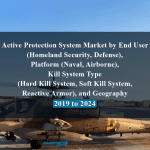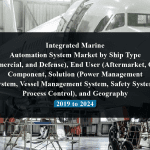OVERVIEW
The Anti-aircraft Warfare Market is currently valued at USD 20.9 billion in 2024 and will be growing at a CAGR of 6.5% over the forecast period to reach an estimated USD 28.6 billion in revenue in 2029. The anti-aircraft warfare market encompasses a diverse array of systems and technologies designed to detect, track, and neutralize airborne threats, ranging from traditional aircraft to modern drones and missiles. This market is driven by the constant evolution of aerial threats and the need for robust defense mechanisms to protect critical assets and populations. Key components of this market include radar systems for early detection, surface-to-air missile systems for interception, and integrated command and control networks for coordinated defense. As nations prioritize air defense capabilities amidst geopolitical tensions and evolving security challenges, the anti-aircraft warfare market is expected to witness steady growth, with innovations in technology and strategic partnerships shaping its trajectory.
Firstly, the proliferation of unmanned aerial vehicles (UAVs) and drones has heightened the demand for advanced air defense systems capable of detecting and neutralizing these emerging threats. Additionally, geopolitical tensions and regional conflicts continue to underscore the importance of robust air defense capabilities, prompting nations to invest in modernizing their anti-aircraft warfare systems. Moreover, advancements in sensor technology, such as radar and infrared systems, are enabling more precise and effective detection and tracking of airborne targets, driving the adoption of next-generation air defense solutions. Furthermore, the increasing integration of artificial intelligence and machine learning algorithms into anti-aircraft warfare systems is enhancing their responsiveness and adaptability to evolving threats, further fueling market growth.
Table of Content
Market Dynamics
Drivers:
Firstly, the proliferation of unmanned aerial vehicles (UAVs) and drones has heightened the demand for advanced air defense systems capable of detecting and neutralizing these emerging threats. Additionally, geopolitical tensions and regional conflicts continue to underscore the importance of robust air defense capabilities, prompting nations to invest in modernizing their anti-aircraft warfare systems. Moreover, advancements in sensor technology, such as radar and infrared systems, are enabling more precise and effective detection and tracking of airborne targets, driving the adoption of next-generation air defense solutions. Furthermore, the increasing integration of artificial intelligence and machine learning algorithms into anti-aircraft warfare systems is enhancing their responsiveness and adaptability to evolving threats, further fueling market growth.
Key Offerings:
The key offerings in the anti-aircraft warfare market encompass a wide range of advanced technologies and systems tailored to detect, track, and neutralize airborne threats effectively. These offerings include state-of-the-art radar systems equipped with long-range surveillance capabilities for early threat detection, as well as advanced missile defense systems capable of intercepting and destroying incoming aerial targets with precision and reliability. Integrated command and control networks play a crucial role in orchestrating the response to aerial threats by providing real-time situational awareness and enabling coordinated action across multiple defense assets. Additionally, emerging technologies such as directed energy weapons and cyber defense solutions are gaining prominence as complementary offerings, promising innovative approaches to enhancing air defense capabilities.
Restraints :
The market for anti-aircraft warfare confronts a number of obstacles that could prevent it from growing, despite the development opportunities. The enormous expense of developing, acquiring, and maintaining sophisticated air defence systems is a major obstacle that keeps many countries, especially those with tight budgets, from being able to afford them. Furthermore, companies working in this industry may find it difficult to expand internationally due to strict regulatory frameworks and export controls governing the transfer of defence technologies, which would limit their potential revenue streams. Furthermore, existing air defence systems face a significant challenge from the sophistication of aerial threats, which includes stealth and manoeuvrability. To keep ahead of these threats, research and development must be continuously invested in. Moreover, demand trends and investment choices in the anti-aircraft warfare market may be affected by geopolitical unpredictability and shifting alliances, which would be an additional challenge for industry participants to overcome. All things considered, these limitations highlight the necessity of innovative thinking and strategic planning to maintain growth in the face of changing obstacles.
Regional Information:
• In North America, the anti-aircraft warfare market is driven by robust defense budgets and ongoing modernization efforts aimed at countering evolving threats. The region benefits from a strong industrial base and technological prowess, with key players continuously innovating to maintain a competitive edge.
• In Europe, heightened security concerns stemming from regional conflicts and terrorist threats have propelled investments in advanced air defense systems, bolstered by collaborations among NATO members to enhance collective defense capabilities.
• In the Asia-Pacific region, escalating geopolitical tensions and territorial disputes have spurred nations to bolster their air defense capabilities, driving significant investments in radar systems, missile defense networks, and indigenous defense projects.
• The Middle East, the proliferation of unmanned aerial threats and the threat of ballistic missile attacks have led to increased demand for integrated air defense solutions, with Gulf countries in particular investing heavily in advanced air defense systems to protect critical infrastructure and assets.
Recent Developments:
• In April 2023, Lockheed Martin, Grand Prairie, Texas, was awarded a USD 2.45 billion modification to contract for Phased Array Tracking Radar Intercept on Target (PATRIOT) Advanced Capability-3 missile production.
• In June 2023, Raytheon integrated air defense systems with radars, command and control systems and interceptors to form a multi-layered shield for air base defense.
Key Market Players:
Lockheed Martin Corporation, Raytheon Technologies Corporation, Northrop Grumman Corporation, BAE Systems plc, Thales Group, and Rafael Advanced Defense Systems Ltd.
Frequently Asked Questions
1) What is the projected market value of the Anti-aircraft Warfare Market?
– The Anti-aircraft Warfare Market is expected to reach an estimated value of USD 28.6 billion in revenue by 2029.
2) What is the estimated CAGR of the Anti-aircraft Warfare Market over the 2024 to 2029 forecast period?
– The CAGR is estimated to be 6.5% for the Anti-aircraft Warfare Market over the 2024 to 2029.
3) Who are the key players in the Anti-aircraft Warfare Market?
– Lockheed Martin Corporation, Raytheon Technologies Corporation, Northrop Grumman Corporation, BAE Systems plc, Thales Group, and Rafael Advanced Defense Systems Ltd.
4) What are the drivers for the Anti-aircraft Warfare Market?
– The rise of UAVs and drones has increased demand for advanced air defense systems, driven by geopolitical tensions and regional conflicts. Advancements in sensor technology, such as radar and infrared, and the integration of artificial intelligence and machine learning algorithms are enhancing these systems’ adaptability.
5) What are the restraints and challenges in the Anti-aircraft Warfare Market?
– The anti-aircraft warfare market faces challenges such as high costs, stringent regulations, evolving aerial threats, and geopolitical uncertainties. These factors limit affordability for nations with budget constraints, hinder international expansion, and require continuous investment in research and development. Strategic planning and innovation are crucial to sustain growth in this complex industry.
6) What are the key applications and offerings of the Anti-aircraft Warfare Market?
– The anti-aircraft warfare market offers advanced technologies for detecting, tracking, and neutralizing airborne threats. These include radar systems, missile defense systems, integrated command networks, and emerging technologies like directed energy weapons and cyber defense solutions. These systems provide real-time situational awareness and coordinated action across defense assets.
7) Which region is expected to drive the market for the forecast period?
– North America is expected to have the highest market growth from 2024 to 2029
Why Choose Us?
Insights into Market Trends: Global Market Studies reports provide valuable insights into market trends, including market size, segmentation, growth drivers, and market dynamics. This information helps clients make strategic decisions, such as product development, market positioning, and marketing strategies.
Competitor Analysis: Our reports provide detailed information about competitors, including their market share, product offerings, pricing, and competitive strategies. This data can be used to inform competitive strategies and to identify opportunities for growth and expansion.
Industry Forecasts: Our reports provide industry forecasts, which will inform your business strategies, such as investment decisions, production planning, and workforce planning. These forecasts can help you to prepare for future trends and to take advantage of growth opportunities.
Access to Industry Experts: Our solutions include contributions from industry experts, including analysts, consultants, and subject matter experts. This access to expert insights can be valuable for you to understand the market.
Time and Cost Savings: Our team at Global Market Studies can save you time and reduce the cost of conducting market research by providing comprehensive and up-to-date information in a single report, avoiding the need for additional market research efforts.












